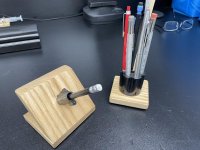I have no way of knowing how much the overcharge was, but it could be a double. The actual load is 2.8 grs, of Tite Group with a 158 gr. bullet and a good roll crimp for Bullseye shooting. I loaded these on a Dillon 550B which I've loaded 10s of 1000s on before. I didn't have my light over the press the night I loaded these for practice.
Jim, the front screw head broke off, I'll have to get the other piece out. Strange thing is this strap was drilled and tapped for a scope rail mount. You can see where the pressure came up through the rear hole it was directly above the latch notch. There was brass vapor around that hole and area, so that probably saved the top strap from being damaged more seriously. I cleaned the window area and didn't see any cracks or damage, I'll measure tomorrow.
The recoil and report of this shot were about the same as the previous 64 shots of the 100 that I loaded.
Austintexas I'll keep you in mind, but I'll see if I can find a blued one first. Thank you for the offer.
Stan



